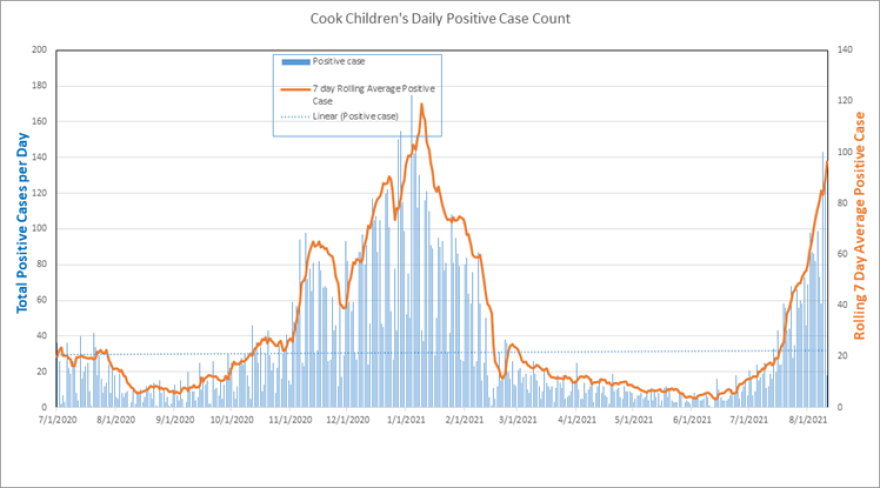Cook Children’s Medical Center in Fort Worth's daily positive coronavirus case count just hit more than 100 and over 14% of tests in the past week have come back positive.
It’s the highest positivity rate they’ve seen since this past winter, when cases spiked at 170 back in January.
“We had a good period of time, couple of months, when we didn’t have any COVID cases at all — and then this dramatically changed,” Dr. Ana Rios said. “A couple of weeks ago, we started seeing more COVID in the emergency room. This reflects what's happening in the community in the adult population, as well as in the other hospitals.”

The more contagious delta variant is one reason for more children being hospitalized in the past few months.
Rios, who focuses on infectious diseases at Cook Children’s, said the delta variant is the biggest reason more children are being hospitalized — because it’s more easily transmitted. She said she’s trying to take it day by day.
“Hopefully, the cases are going to start decreasing again and the middle of September will be a little better,” Rios said. “But there is no clear way of me telling you how September or October are going to be. Everything depends on what happens with the vaccine, and hopefully more people continue taking the vaccine [which means] we have less chances of developing more variants.”
Children 12 years and older are authorized to receive the Pfizer vaccine, but vaccinations among young people ages 12-15 are lagging in Texas. More than 451,000 children are fully vaccinated, which means statewide a little over 3 out of every 4 people ages 12-15 are not fully vaccinated.
Returning to school could increase cases numbers in Texas, even if children have a lower risk of serious symptoms.
With most students in the state headed back to school in person next week, those numbers are also concerning to Emma Dishner, a doctor with North Texas Infectious Diseases Consultants. The Dallas and Fort Worth school districts, along with others across the state, recently issued masking requirements for students and staff to help slow the spread of the virus.
Rios said children in general are less likely to have severe COVID-19 symptoms. Many present with cold symptoms or no symptoms at all. The majority of the young people hospitalized at Cook Children’s have underlying risk factors, like obesity, diabetes or asthma. But Rios said there’s not enough data on how kids contracting the delta variant, even in mild cases, will pan out in the long run.
It’s not just children contracting the virus that concerns Dishner, it’s also the fact that adult vaccination rates have slowed and most North Texans in the hospital due to COVID-19 have not been vaccinated.
“Those children, if unmasked and in close quarters, are most likely to bring the virus home, whether or not they get that sick,” Dishner said. “Multi-generational households are going to be the most at risk of being decimated by this virus.”
Since July, the number of inpatients overall being treated for COVID-19 in hospitals across Dallas County has gone from under 200 to a little over 700 in August.
“This is preventable,” Dishner said. “I think that has been the saddest part about my life in the past month. I see people every day, and this could have been prevented.”
Rios said she encourages people to get their children vaccinated if they are 12 or older, and wear masks in any indoor setting, including schools. She’s also looking to the fall, which typically means an increase in flu and respiratory viruses.
“[Last] December, in the winter, we didn’t see any respiratory viruses,” Rios said. “So it’s a little unpredictable as to what’s coming in the fall and the winter [this year]. We will see.”
Got a tip? Email Elena Rivera at erivera@kera.org. You can follow Elena on Twitter @elenaiswriting.
KERA News is made possible through the generosity of our members. If you find this reporting valuable, consider making a tax-deductible gift today. Thank you.







